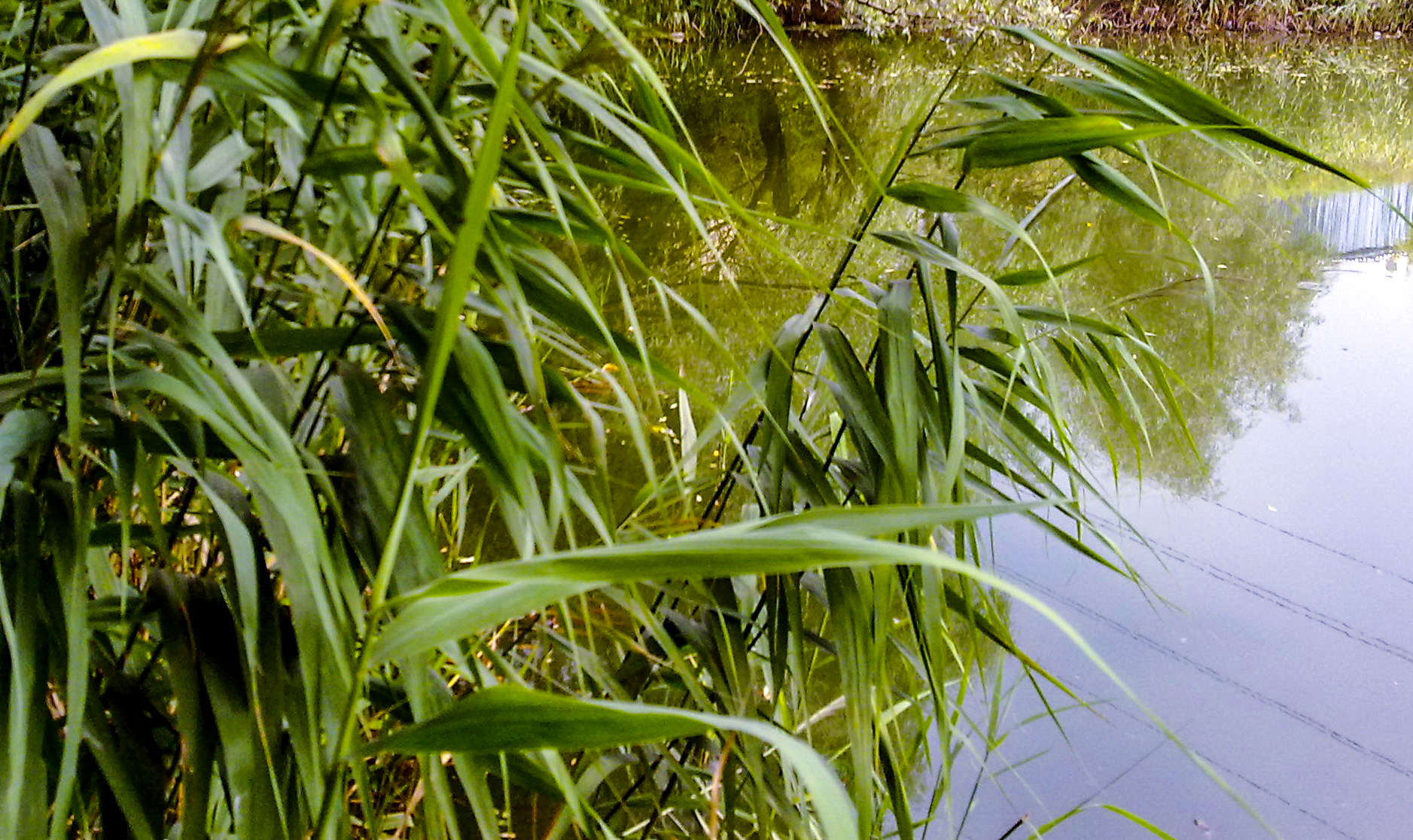Morphological and anatomical characteristics of Phragmites australis from Dnipro channel
Abstract
Field and experimental studies of morphological and anatomical leaf parameters of Phragmites australis showed the structural adaptation of these plants to growth under different water supply regimes. The anatomical structure of the leaves of common reed, which grew in shallow water and dry land in the Venice channel of the Dnipro river in Kyiv, was studied with the light microscopy. The obtained results suggest that the anatomical structure and type of mesophyll cells are stable parameters for this species, while the size both of the leaf blade and its cells can be considered as adaptive and labile features varying depending on the conditions of water supply.
References
Brix H. 1999. Editorial. Genetic diversity, ecophysiology and growth dynamics of reed (Phragmites australis). Aquat. Bot. 64: 179–184. https://doi.org/10.1016/S0304-3770(99)00050-9
Chen L., Jiang W., Jiang L., Chen T., Xu X. 2013. A comparative analysis of leaf anatomical and photosynthetic characteristics of Phragmites australis from two different habitations. Life Sci. J. 10 (1): 1022–1029.
Clevering O.A., Lissner J. 1999. Taxonomy, chromosome numbers, clonal diversity and population dynamics of Phragmites australis. Aquat. Bot. 64: 185–208. https://doi.org/10.1016/S0304-3770(99)00059-5
Granier Ch., Tardie F. 1999. Water deficit and spatial pattern of leaf development. Variability in responses can be simulated using a simple model of leaf development. Plant Physiol. 119 (2): 609–619. https://doi.org/10.1104/pp.119.2.609
Hanganu J., Mihail G., Coops H. 1999. Responses of ecotypes of Phragmites australis to increased seawater influence: a field study in the Danube delta, Romania. Aquat. Bot. 64: 351–358. https://doi.org/10.1016/S0304-3770(99)00062-5
Hansen D.L., Lambertini C., Jampeetong A., Brix H. 2007. Clone-specific differences in Phragmites australis: Effects of ploidy level and geographic origin. Aquat. Bot. 86: 269–279. https://doi.org/10.1016/j.aquabot.2006.11.005
Insausti P., Grimoldi A.A., Chaneton E.J., Vasellati V. 2001. Flooding induces a suite of adaptive plastic responses in the grass Paspalum dilatatum. New Phytol. 152: 291–299. https://doi.org/10.1111/j.0028-646X.2001.257_1.x
Jackson M.B., Drew M. 1984. Effects of flooding on growth and metabolism of herbaceous plants. In: Kozlowski T.T. (ed.), Flooding and plant growth: 47–128. Academic Press, Orlando, Florida.
Kühl H., Koppitz H., Rolletschek H., Kohl J.G. 1999. Clone specific differences in a Phragmites australis stand. I. Morphology, genetics and site description. Aquat. Bot. 64: 235–246. https://doi.org/10.1016/S0304-3770(99)00053-4
Lessmann J.M., Brix H., Bauer V., Clevering O.A., Comin F.A. 2001. Effect of climatic gradients on the photosynthetic responses of four Phragmites australis populations. Aquat. Bot. 69: 109–126. https://doi.org/10.1016/S0304-3770(01)00133-4
Lu J.M., Zhang C.Z., Zhang H.Q. 1994. The character of morphology anatomy of monocotyledons in saline-alkali soil of resistant and the study physiological adaptability interrelation. J. NE Normal Univ. 21: 79–82.
Matthias P., Herskowitz I. 1994. Joining the complex cyclin-dependent kinase inhibitory proteins and the cell cycle. Cell 79: 181–184. http://dx.doi.org/10.1016/0092-8674(94)90186-4
Mollard F.P.O., Striker G.G., Ploschuk E.L., Insausti P. 2010. Subtle topographical differences along a floodplain promote different plant strategies among Paspalum dilatatum subspecies and populations. Austral. Ecol. 35: 189–196. https://doi.org/10.1111/j.1442-9993.2009.02026.x
Packer J.G, Meyerson L.A., Skalove H., Pysek P., Kueffer Ch. 2017. Biological flora of the british Isles: Phragmites australis. J. Ecol. 105: 1123–1162. http://dx.doi.org/10.1111/1365-2745.12797
Pauca-Comanescu M., Clevering O.A., Hanganu J., Gridin M. 1999. Phenotypic differences among ploidy levels of Phragmites australis growing in Romania. Aquat. Bot. 64: 223–234. https://doi.org/10.1016/S0304-3770(99)00052-2
Rolletschek H., Rolletschek A., Kühl H., Kohl J.G. 1999. Clone specific differences in a Phragmites australis stand II. Seasonal development of morphological and physiological characteristics at the natural site and after transplantation. Aquat. Bot. 64: 247–260. https://doi.org/10.1016/S0304-3770(99)00054-6
Setter T., Flannigan B.A. 2001. Water deficit inhibits cell division and expression of transcripts involved in cell proliferation and endoreduplication in maize endosperm. J. Exp. Bot. 52: 1401–1408. https://doi.org/10.1093/jexbot/52.360.1401
Sobrado MA. 2007. Relationship of water transport to anatomical features in the mangrove Laguncularia racemosa grown under contrasting salinities. New Phytol. 173: 584–591. https://doi.org/10.1111/j.1469-8137.2006.01927.x
Stebbins G.L. 1971. Chromosomal evolution in higher plants. Edward Arnold, London.
Voesenek L.A.C.J., Rijnders J.H.G.M., Peeters A.J.M., van de Steeg H.M., de Kroon H. 2004. Plant hormones regulate fast shoot elongation under water. From genes to communities. Ecol. 85 (1): 16–27. https://doi.org/10.1890/02-740
Wang H.L., He C.L., Liang. H.G. 1995. Seasonal changes of polyamines in habitat adaptation of different ecotypes of reed plants. Oecologia 101: 119–123. http://www.jstor.org/stable/4220860
Yermakov A.I. 1982. Determination of content of water and active acidity in plant material. In: Yermakov A.I. Methods of biochemical investigations of plants: 21–35. Agropromizdat, Leningrad.


This work is licensed under a Creative Commons Attribution-NonCommercial-NoDerivatives 4.0 International License.
The journal is licensed by Creative Commons under BY-NC-ND license. You are welcome and free to share (copy and redistribute the material in any medium or format) all the published materials. You may not use the material for commercial purposes. You must give appropriate credit to all published materials.
The journal allow the author(s) to hold the copyrights and to retain publishing rights without any restrictions. This is also indicated at the bottom of each article.





